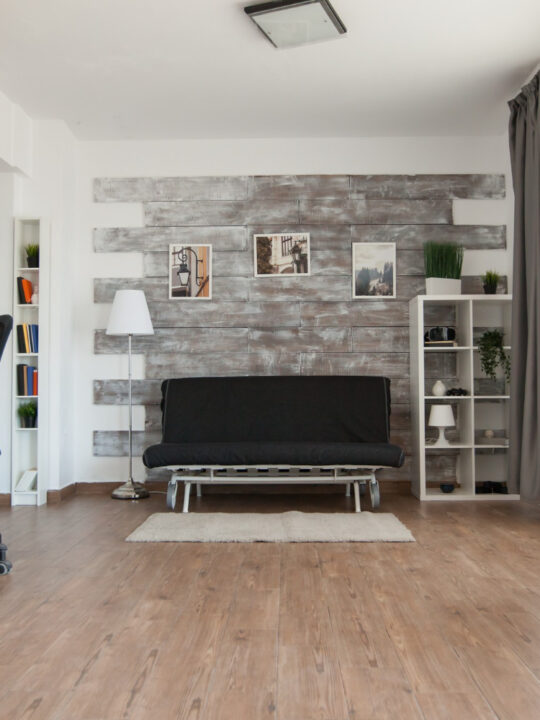
An unorganized closet can be a nightmare — especially in the morning when you’re trying to get dressed for the day.
If you can admit that you have this problem, then it’s time to do something about it!
Reorganizing and decluttering isn’t hard to do, but it does take some time.
Maybe you want to boil your closet down into a capsule wardrobe. Perhaps you’re just looking to reclaim your space and create a closet that’s actually functional.
If you’re ready to tackle that mess of yours, here are our five favorite tricks to reorganize your closet and remove clutter in three weeks.
Table of Contents
1. Pick a Place to Start
It’s always best to empty your closet completely and start with a blank slate.
But depending on how much you own and how big your closet is, that can take hours upon hours. So if you’re trying to work on it a little bit at a time, just pick a place and start.
You can start with your clothing rod, your shelves, or the floor — there’s no right or wrong way. With that said, top to bottom is the best way to clean (and cleaning is required).
Empty off your shelves and dust them. Get everything off the floor and sweep it or vacuum it. There’s no point in organizing your closet if it’s dusty or dirty inside.
2. Go Through Every Item You Own
Ready to get to work? Good, because here’s where the hard part starts.
Make your bed and get ready to create three different piles: keep, donate, and trash. You’ll need to go through every single item and decide which of those three heaps each piece belongs in.
For most people, deciding what to donate often takes the most time.
What to Trash
If items are stained, damaged, or worn out, trash them. Try not to be too sentimental or waste time thinking about how much fun you had the last time you wore that dress. You have to be methodical about it.
What to Keep
Items that you wear on a regular basis should go right into your keep pile.
Whittling down your wardrobe and decluttering your closet does not mean you have to get rid of the things you love.
What to Donate
Now here’s the tricky part:
Deciding how to part with items that are still wearable.
Donate anything that doesn’t fit or that you never really loved in the first place.
While you’re doing this, try not to think about how much money you’ve spent on clothing over the years. Now is not the time to beat yourself up for your out of control retail habits!
Donate things that you’ve only worn once or twice and probably won’t ever wear again and things that aren’t your style anymore.
Remember, the less you keep, the easier it will be to organize!
Do you have unworn items that still have tags attached? Consider donating them to a back-to-school clothing drive or a charity that provides work clothes for lower-income job seekers.
3. Get the Right Organizational Tools
If your closet got utterly out of hand, it’s probably because you didn’t have the right organizational tools in the first place.
Before you start putting items back in, gather a few tools to make the job easier. Here’s a shopping list for your next Target run or Amazon haul:
- New hangers — the slim ones that grip items and maximize space
- Shoe racks — get a rack for the closet floor or a hanging organizer to put over the door
- Storage boxes — these are a must-have for miscellaneous items such as scarves, hats, and seasonal items
- Hanging shelves — you’ll lose hanger space on your rod, but you’ll have more storage for folded items
- An additional rod — if you want to double up on storage, mount an additional bar
With your tools by your side, it’s time to get to the fun part: putting it all back together!
4. Start Building the Closet You Want and Need
Take a look at everything you plan to keep and assess what you’re dealing with.
Is there room for everything? If not, you may have to weed through it again and try to whittle it down a bit more.
Think about what you have the most of.
For example, do you have tons of sweaters and jeans that you need to fold? If so, consider mounting an additional shelf or making use of hanging shelves.
Do you have tons of tops, pants, and short dresses but not a lot of items with longer lengths? Think about adding a second bar so that you can maximize the height of your closet and enjoy double the bar space.
There are lots of inexpensive closet organizers out there, so don’t feel as though you’re limited to the closet you have with one single bar and a shelf on top.
There are endless ways to customize a closet, even if it’s small.
5. Arrange Your Clothing in a Uniform Way
There’s no right or wrong way to organize clothing. Some people do it by type, some by color, and some by season.
But you can also organize it by how often you wear items.
To do this, place the items you wear most often in the most accessible area of your closet. The things you wear least often can go towards the back. Many people find this method useful, and it will make next year’s clothing purge even easier!
When it comes to bulky sweaters, consider storing them in bins rather than stacking them in sloppy piles high on a shelf. As for shoes, take them all out of their boxes and place them along the closet floor or on your recently purchased shoe rack.
How you organize is entirely up to you. The trick is to find a way that works for your lifestyle!
Tired of having to sort through a mess of clothing to find that one sweater you want to wear? Wondering where those boots you bought last winter disappeared to?
If so, it’s time to reorganize your closet with these five tricks:
- Pick a place to start (if you can, empty it out and start with a blank slate)
- Go through every single item you own
- Get the right organizational tools
- Add shelves or extra bars to make your closet as functional as possible
- Arrange your clothing in a way that makes sense to you
Do a little bit today and a little bit next weekend, and within two or three weeks, you can create the closet of your dreams!
Client headshot:

Client bio:
Carron McEntire oversees all aspects of operations at Midtown Commons at Crestview Station. Carron brings years of experience to the community to effectively and efficiently handle the concerns and needs of the customer.







